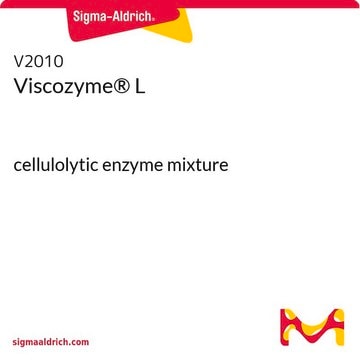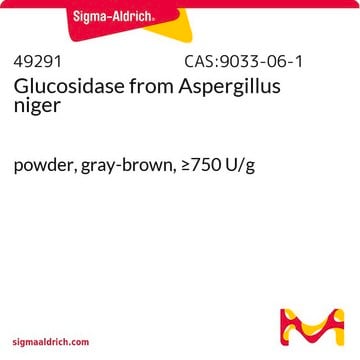SAE0020
Cellulase, enzyme blend
Synonym(s):
Cellic CTec2
Sign Into View Organizational & Contract Pricing
All Photos(3)
About This Item
UNSPSC Code:
12352204
NACRES:
NA.54
Recommended Products
General description
Cellulase is a member of glycoside hydrolase family and is produced by a number of cellulolytic microbes.
This product contains cellulases, ß-glucosidases, and hemicellulase, for the application of degrading cellulose to fermentable sugars. This product is effective on a wide variety of pre-treated lignocellulosic bimass materials, for converting the carbohydrates in these materials into simple sugars prior to fermentation, for application in biofuels research.
Application
Cellulase, enzyme blend has been used for the purpose of enzymatic hydrolysis.
Biochem/physiol Actions
Cellulase is responsible for the breakdown of insoluble plant polymer cellulosic substrates into soluble sugars, mostly cellobiose and glucose. It specifically catalyzes the hydrolysis of β -1,4 glucosidic bonds in cellulose. Animals do not naturally possess the ability to digest cellulose, but do so with the help of gut microorganisms.
Legal Information
A product of Novozyme Corp
Signal Word
Danger
Hazard Statements
Precautionary Statements
Hazard Classifications
Resp. Sens. 1
Storage Class Code
10 - Combustible liquids
WGK
WGK 3
Choose from one of the most recent versions:
Certificates of Analysis (COA)
Lot/Batch Number
Don't see the Right Version?
If you require a particular version, you can look up a specific certificate by the Lot or Batch number.
Already Own This Product?
Find documentation for the products that you have recently purchased in the Document Library.
Customers Also Viewed
Sigrid Hakvåg et al.
Frontiers in microbiology, 11, 680-680 (2020-04-25)
The facultative methylotroph Bacillus methanolicus MGA3 has previously been genetically engineered to overproduce the amino acids L-lysine and L-glutamate and their derivatives cadaverine and γ-aminobutyric acid (GABA) from methanol at 50°C. We here explored the potential of utilizing the sugar
Angela S Machado et al.
Frontiers in bioengineering and biotechnology, 8, 826-826 (2020-08-09)
The ability of white-rot fungi to degrade polysaccharides in lignified plant cell walls makes them a suitable reservoir for CAZyme prospects. However, to date, CAZymes from these species are barely studied, which limits their use in the set of choices
Liwen He et al.
Frontiers in microbiology, 12, 690801-690801 (2021-09-14)
Vanillic acid (VA) is a phenolic acid derivative commonly found in plants and foods, with a pleasant creamy odor and pharmacologic activities, which is hypothesized to help improve silage fermentation. The silage profile of stylo silage ensiled with addition of
Chenhuan Lai et al.
Bioresource technology, 288, 121569-121569 (2019-06-11)
A novel combined pretreatment process of poplar sawdust was established in this study based on the sequential acetic acid and alkali treatment with poly (ethylene glycol) diglycidyl ether (PEGDE). Effects of each treatment step on chemical composition, cellulose accessibility, and
Celluclast and Cellic? CTec2: Saccharification/fermentation of wheat straw, solid?liquid partition and potential of enzyme recycling by alkaline washing.
Rodrigues, A.C., et al.
Enzyme and Microbial Technology, 79-80, 70-77 (2015)
Our team of scientists has experience in all areas of research including Life Science, Material Science, Chemical Synthesis, Chromatography, Analytical and many others.
Contact Technical Service










